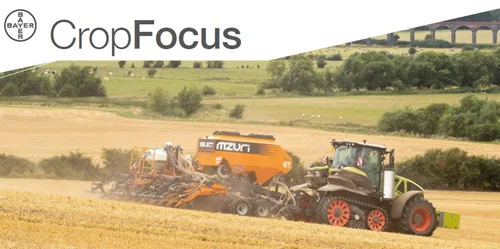
Atlantis Star adds a new active (thiencarbazone) to mesosulfuron and iodosulfuron
Offers ‘best-in-class’ grass-weed control
Wider broadleaf spectrum than Pacifica Plus
Good application timing and technique is vital to protect efficacy
Author
| 1st February 2023Extra active keeps up the pressure on grass-weeds
Post emergence herbicides
Post emergence herbicides, as well as hand-rogueing and patch control with Roundup (glyphosate), can all play a role in reducing weed numbers and seed return.
Farmers considering a post-em to control black-grass, Italian ryegrass and brome now have the option of Atlantis Star, which sees a new active, thiencarbazone, added to mesosulfuron and iodosulfuron. It is effective against a wide range of grass and broad-leaf weeds.
“It’s a step forward from Pacifica Plus (mesosulfuron + iodosulfuron + amidosulfuron),” says Bayer’s campaign manager Tom Chillcott.
Mr Chillcott recognises that resistance, particularly in black-grass, is often the first thing people think about with post-ems. “We know a lot of farms have problems with resistance and have dropped the post-em from the programme. But, there are still lots of susceptible weeds out there.”
Bayer’s resistance testing has shown that 15% of black-grass samples sent in and suspected of resistance were in fact still susceptible. This climbs to 58% with respect to ryegrass.
“The NIAB/ Bayer ryegrass survey, showed a similar thing, with more populations of susceptible ryegrass than perhaps people expect. The main thing is that resistance varies field-by-field. Where there are susceptible weeds, a spring application of a product like Atlantis Star can make a lot of difference to overall weed control.”
Benefit of additional control
Atlantis Star is the best-in-class for post- emergence grass-weed control, offering on average 5% additional control compared to the next best Pacifica Plus, and it extends the broad-leaf weed spectrum to cranesbill and speedwells.
“We have trialled this product for a number of years, so we have a good understanding of its strengths,” says Mr Chillcott.
“It has also been available as Proverb with a limited distribution and has performed well, which is why we decided to make it available to everyone.”
In 20 field trials, Atlantis Star averaged 60.5% control of black-grass, versus 56% for Pacifica, this included some with EMR black-grass. Against brome (16 trials), the results were 85% for Atlantis Star and 75% for Pacifica, although other trials work has shown a much greater improvement against meadow-brome and rye-brome. Against Italian ryegrass, Atlantis Star is better than Pacifica Plus and ahead of competitor products like Broadway Star.
Chishill Weedscreen 2017-2022: thiencarbazone offers something extra
5% improvement in black-grass for Atlantis Star over class leading Pacifica Plus.
Greater improvements for Atlantis Star seen in both meadow and rye brome species.
5-year average of weedscreen data at spring application timings (March/April).
Programme always includes Liberator 0.6 L/ha applied at pre-emergence followed by ALS application in spring.
Resistant strains are where a degree of ALS resistance has been discovered.

Reducing seed return
Mr Chillcott emphasises that 5% greater control can make quite a difference when it comes to yield and seed returns.
“In the 20 field trials, the average number of untreated black- grass heads was 233. That means using Atlantis Star left 92 heads on average, but Pacifica left 102, a difference of 10 heads.”
In terms of seed, that probably means 1,000-2,000 fewer seeds returned to the seedbank. For yield, AHDB Project Report 560 indicates that every additional 100 heads/m2 of black-grass causes 1.08 t/ha yield loss.
“Ensuring that as few viable seeds as possible reach the seedbank is fundamental for long-term weed control. It doesn’t matter which weed we are talking about, if there are fewer seeds in the ground at the end of the season than the start, then weed control has been successful. Adding a post-em into the programme gives farmers the best chance to reach
this goal.”
For farmers using Atlantis Star or other contact-acting chemistry this spring, Mr Chillcott stresses that application technique is absolutely vital. The spray needs to land, settle, then dry on a fairly small blade of grass to take effect. Large droplet size, dewy and windy conditions can all cause the spray to not stay on the target.
New active – thiencarbazone
The newly available active has the same mode of action as mesosulfuron and iodosulfuron.
It is in HRAC Group 2 – Inhibition of Acetolactate Synthase (ALS). But it does have quite a different chemical structure because it is a triazolinone, not a sulfonylurea like mesosulfuron.
Exactly how the difference in structure will interact with resistant weeds is not known, but in general, any diversity in actives can reduce the effect of metabolic resistance and slow the development of resistance overall. The main uptake of thiencarbazone is through the leaf, so like other contact- acting herbicides, application timing and technique will be very important. Atlantis Star is approved for applications from growth stage 13 – 32 from 1 February.
This article is an extract from CropFocus magazine, if you would like to sign up for the next issue please sign up here
